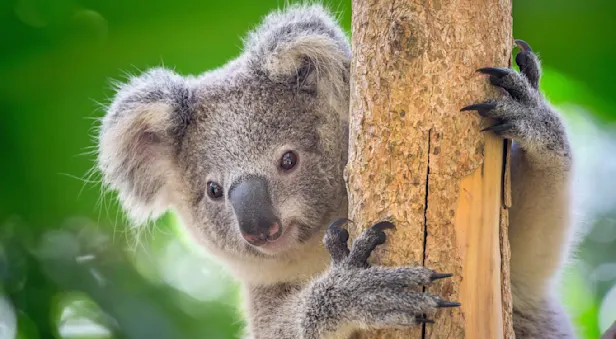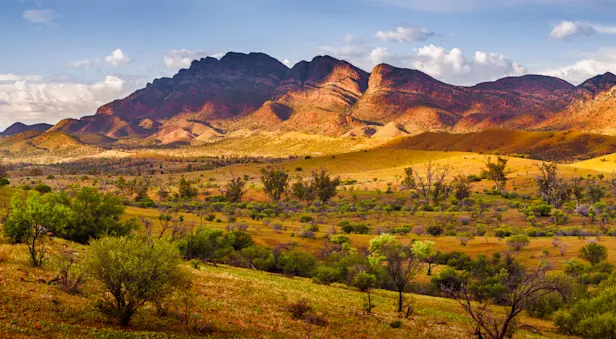Natural History of Australia
Australia – Evolution’s Laboratory
While the Galapagos Islands are most often associated with Darwin’s theory of natural selection, his journals show that Australia is the place where this new understanding truly began to coalesce.
One can only imagine the flurry of thoughts in this naturalist’s curious brain upon seeing egg-laying mammals like the platypus which seemed to be an odd blending of a beaver and a duck and behaved like the European water rat. Upon receiving a specimen of a platypus in 1799, London biologist George Shaw, assuming it was a hoax, cut the skin at the base of the bill looking for the stitching. Charles Darwin saw them in the wild 37 years later when their taxonomy was still under considerable debate. His great-great-grandson, Chris Darwin, refers to the family legend of the “platypus moment” that was a watershed in the elder Darwin’s thinking about evolution and natural selection.
It was an antlion in Australia that seems to have finally forced him to question his deep-seated, Creationist beliefs. An antlion is the larval stage of an insect that is very similar to a lacewing or dragonfly. It burrows into sand and creates a conical trap that ants can’t escape. The species he saw in Australia was clearly related to the one he knew in England, but they were not the same. His journal entries from his time in Australia capture the internal struggle he seemed to be having between his observations and his beliefs. Why would a single Creator bother to create two different antlion species to fill the same niche? But he was not quite ready, as he would be in later years, to trust his theory:Now what would the Disbeliever say to this? Would any two workmen ever hit on so beautiful, so simple & yet so artificial a contrivance? It cannot be thought so. — The one hand has surely worked throughout the universe.He knew his nascent theory of natural selection would not be popular in the scientific or religious communities. That is likely why it took him 20 years after his voyage on The Beagle to publish his findings. He felt compelled to bolster his case with as much evidence as possible, from as many locations as possible. He continued to receive specimens from Australia long after his visit and maintained correspondence with several scientists and one of his old shipmates who returned to settle in New South Wales.
A Living Textbook
To this day, Australia remains a living textbook for understanding evolution through natural selection. This is the only country where a traveler can find all three types of mammals—marsupials (pouched mammals), monotremes (egg layers) and placentals (species like ours). Some of the most ancient plants in the world are found in the Daintree Rainforest. Species that pre-date flowering plants by tens of millions of years are growing right next to some of the first flowering plants. Australia is also home to one of the oldest human cultures on the planet. Aborigines have thrived through a deep connection to this land for over 60,000 years. Although it sounds like a cliché, it truly is like no other place on Earth.
The Three Paths to Mammal hood
There are three broad categories of mammals: Monotremes (egg-layers), Marsupials (born underdeveloped and usually carried in a pouch–a marsupium–for months) and Placentals (animals like us, that develop in a womb nourished by the mother’s blood through a placenta).
Australia is the happy place for marsupials. The reason for their short gestation time in the womb (often just a few weeks) is that unlike a placental mammal, where the mother’s blood supply brings nutrients to the developing fetus, marsupials feed off a yolk – a limited nutrient source–until they are born and attach to the mother’s nipple.
Australia has approximately 200 species of marsupials. South America has approximately 120 species and North America has one. The roots of this distribution reach back to when South America, Antarctica and Australia were all connected as part of Gondwana and animals could move freely across this entire range. Marsupials branched off from the placental mammals about 160 million years ago.
There are a number of advantages to the marsupial approach to reproduction. Being in the pouch allows young to nurse and remain protected from predators. The mothers are also able to take advantage of good conditions because they can have three young at three different stages of development: One still inside the womb, one in the embryonic stage attached to the nipple and one outside the pouch but still suckling. The two nipples each produce a different kind of milk appropriate to the stages of development of the young. In poor conditions, it is easy to abort the fetus that is in the pouch and delay the birth of the fetus that is still in the womb.
So why did placental mammals take over the rest of the world and why did marsupials take over Australia? And why do egg-laying mammals (monotremes) only survive in Australia today?
One theory comes down to energy budgets. Australia is the driest and has the least fertile soils of any continent on earth, and the vegetation (except in lush areas like the Daintree Rainforest) is accordingly low in nutrients. Placental mammals have the highest metabolic needs of the three types of mammals. They disappeared from Australia and thrived in more-fertile South America and everywhere else. Egg-laying mammals have the lowest metabolic needs and only survived in Australia, presumably because placental mammals were not there to displace them. Marsupials have intermediate energy needs between the other two, and they survived in both places and took over Australia where they had no competition from placental mammals.
Survival at the Edge
Despite its profuse biodiversity, Australia is a very difficult place to survive, and many species live right at the edge of existence. It is the driest continent inhabited by humans, so it is remarkable that Aborigines thrived across the landscape for 60,000 years, long before it was an option to dig wells to tap the Great Artesian Basin which underlies much of the eastern quarter of the country. Many small towns in the Outback are named after the springs that allowed them to be developed. Today, thousands of boreholes are extracting water from the aquifer much more quickly than it is being replaced.
To make life even more difficult, it has the least-fertile soil of any continent due to the lack of any recent glacial, volcanic or tectonic activity that would bring up fresh soil (it is also the flattest continent for the same reason).
In a land of extremes, where existence takes determination, minor shifts in climate can result in major challenges to life. It is likely that the impacts of climate change will be more severe in Australia than in most other industrialized countries. Droughts, already a regular occurrence in this dry land will become longer, more severe and more frequent. Vegetation that is needed by both livestock and wildlife will become sparser. And marine species will struggle to adapt to warmer ocean temperatures.
Over 80% of Australia’s mammals, plants, reptiles and frogs can’t be found anywhere else. The geological isolation of the continent for millions of years allowed a unique biodiversity to develop that must be protected. While you are on this journey, know that you are walking through the history of evolution, seeing species that exist nowhere else on Earth and helping those species just by visiting the national parks and preserves that were created to protect their habitats.
Explore Australia on These Adventures

Australia South: Tasmania, Kangaroo Island & the Great Ocean Road
Discover the diverse landscapes and ecology of far-south Australia as we explore four national parks and a host of private nature reserves teeming with endemic and endangered wildlife.

























